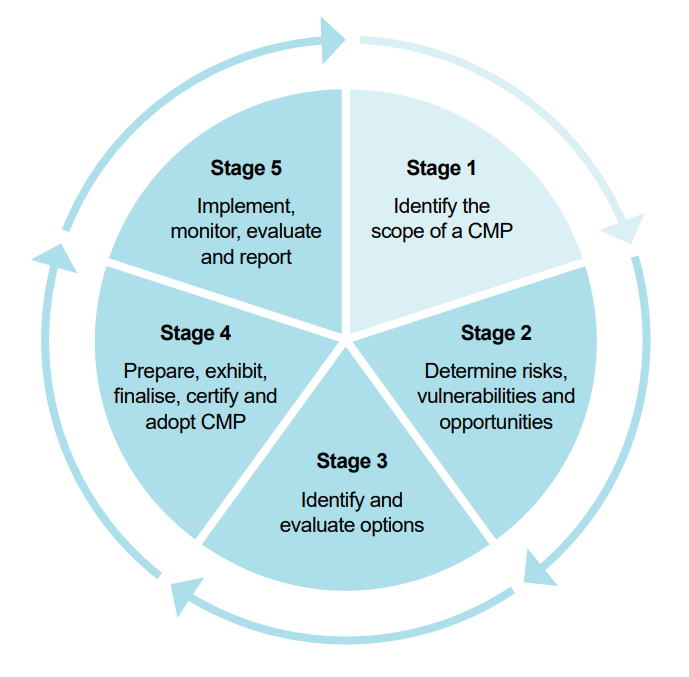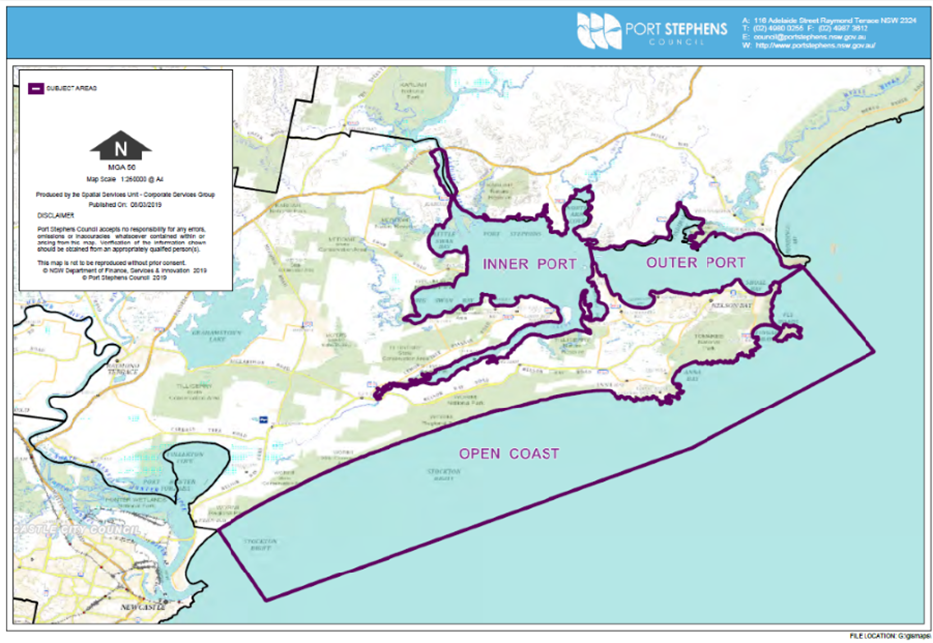Port Stephens Coastal Management Program
We've developed a Port Stephens Coastal Management Program (CMP) to provide a framework for managing priority coastal threats now and into the future.
The Port Stephens CMP covers the open coast, inner port and outer port within the Port Stephens local government area. See stage 1 below for more information about the scope of the Port Stephens CMP.
The Port Stephens CMP sets the long-term strategy for the coordinated management of the coast. Coastal zones are continually changing. It's important to have an understanding of the risks and hazards associated with coastal zones to enable better planning, management and continued enjoyment of the coast now and into the future.
This CMP is not just for Council use but has been designed to guide the management of the coast for all our community.
The CMP has identified the coastal management issues in Port Stephens, the actions required to address these issues, and how and when those actions will be implemented. We have also identified the costs of the actions, proposed cost-sharing arrangements and viable funding mechanisms to ensure the delivery of our CMP.
In summary, some of the key benefits of having a certified CMP in place are:

Development of the CMP
The CMP was developed in line with the objectives of the Coastal Management Act 2016 (CM Act) and according to the NSW Coastal Management Manual’s five-step process (refer to figure below).

The final CMP was certified by the State Minister for the Environment in November 2024. Implementation of the Port Stephens CMP is estimated to begin in late 2025.
Stage 4 of the Port Stephens CMP involved bringing together the findings from the previous three stages into a comprehensive suite of documents.
The final draft version of the CMP was endorsed by Council on 25 June 2024 to proceed to the next step of approval: certification by the Minister for the Environment.
Key Documents For Stage 4
- Coastal Management Plan Stage 4 Report (PDF 116.3 MB)
In November 2022 we engaged Rhelm, a specialist consulting company to help deliver the remaining Stage 3 and Stage 4 of our CMP. Rhelm supported by Blue Coast, a coastal engineering company, in developing the draft plan and the assessment of the viability of potential management options.
Stage 3 included feedback opportunities for key stakeholders and has helped determine the following:
- Management options for the key coastal threats
- Management options for other key risks and opportunities for sustainable coastal management
- Feasibility of the management options including economic viability assessment undertaken by consultant.
The information collected during Stage 3 has been used to help draft the Coastal Management Plan see Stage 4 above.
What do management options look like?
One of the most effective ways to manage the risk of coastal hazards is through strategic land use planning and development controls. The draft management options for the CMP were developed from the engagement undertaken in Stage 3.

Key Documents For Stage 3
- Community Update: Management Options June 2023 (PDF 2.8 MB)
- Coastal Hazards Fact Sheet - May 2023 (PDF 3.3. MB)
- Stage 3 start community update - March 2023 (PDF 3.4 MB)
- Coastal Management Program Stage 3 Report (PDF 34.8 MB)
The modelling of the coastal hazards was conducted during stage 2 of the Coastal Management Program (CMP) and detailed within the BMT Report.
To help understand the hazard mapping we’ve developed a video and fact sheet explaining each of the hazards in the maps. Cohesive maps have been created to show all of the hazards for 2020 and 2120. These are the same hazards detailed in the BMT Stage 2 report.
Coastal Inundation Map
Tidal Inundation Map
Quick reference to help with reading the maps:
Coastal erosion – mapped against each planning period - 2020, 2040, 2070 and 2120.
The current mapping covers the ‘open coast’ area, not the ‘outer port’ or ‘inner port’ of Port Stephens.
Tidal inundation – mapped against each planning period - 2020, 2040, 2070 and 2120.
With tidal inundation we’ve used Highest Astronomical Tide (HAT) as the measure. The tidal inundation mapping (HAT mapping) shows the highest possible tidal water level that could occur and corresponds roughly to the extent of inundation that you might witness once or twice a year. Low lying land would be inundated for a period of hours during HAT.
Coastal inundation which is also known as storm tide inundation (STI) and this is presented in terms of a ‘design storm’ event. For the Port Stephens CMP the two design storm events considered were:
- 5% Annual Exceedance Probability (AEP)
- 1% Annual Exceedance Probability (AEP)
The AEP describes the likelihood of that design storm occurring in any given year. Therefore, a 1% AEP storm tide event has a 1% chance of occurring in any given year and is otherwise known as the ‘1 in 100 year event’. There is at least a 50% chance that you will experience a 1% AEP coastal inundation event in your lifetime. A 5% AEP storm tide event has a higher likelihood of occurrence, translating to a 97% chance you will experience at least once such event in your lifetime. A 5% AEP is also known as a 20-year Average Recurrence Interval (ARI), and a 1% AEP is also known as a 100-year ARI.
For each AEP level, we’ve mapped them for each planning period - 2020, 2040, 2070 and 2120.
Dune transgression – mapped against planning periods 2020, 2040 and 2070.
The mapping only applies to the sand dunes in the Stockton Bight and due to the unpredictable nature of dune transgression we were only able to map until 2070.
Key Documents For Stage 2
- Coastal Management Program Stage 2 Report (PDF 322 MB)
Stage 1 established the scope of the Port Stephens CMP via a scoping study and a range of priority threats affecting the Port Stephens coastal zone.
The coastal zones are identified as the open coast, inner port and outer port (refer to the figure below).

Please note that the remaining areas of Port Stephens will be covered by a separate CMP which is being developed in conjunction with Newcastle, Maitland and Dungog councils which is called the Hunter Estuary Coastal Management Plan. This plan is currently at Stage 1. To learn more about this project go to the Hunter Estuary CMP here
The coastal threats identified as part of the scoping study included:
- Coastal hazard threats
- Water quality threats
- Biodiversity threats
- Development and industry threats
- Recreational activity threats
Key Documents For Stage 1
- What are our coastal hazards? Community update - November 2020 (PDF 520 KB)
- Coastal Management Program Stage 1 Scoping Study Key Points (PDF 1.6 MB)
- Coastal Management Program Stage 1 Scoping Study Full Document (PDF 3.3 MB)
For more information about the development of a CMP please refer to the following key links
Key documents and links
- Port Stephens Coastal Management Program (CMP)
- Council report – 27 February 2024
- Draft Port Stephens Coastal Management Program summary document (PDF 11.1 MB)
- Community Update: Management Options June 2023 (PDF 2.8 MB)
- Coastal Hazards Fact Sheet - May 2023 (PDF 3.3. MB)
- Stage 3 start community update - March 2023 (PDF 3.4 MB)
- Coastal Management Program Stage 3 Report (PDF 34.8 MB)
- Coastal Management Program Stage 2 Report (PDF 185.3 MB)
- What are our coastal hazards? Community update - November 2020 (PDF 520 KB)
- Coastal Management Program Stage 1 Scoping Study Key Points (PDF 1.6 MB)
- Coastal Management Program Stage 1 Scoping Study Full Document (PDF 3.3 MB)
- Coastal Management Plan Stage 4 Report (PDF 116.3 MB)

